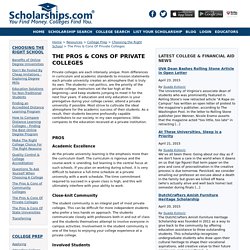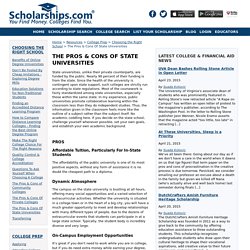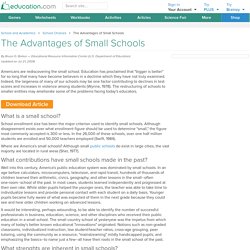

The Pros And Cons Of Private Colleges - Choosing The Right School - College Prep - Resources - Scholarships.com. Private colleges are each intensely unique.

From differences in curriculum and academic standards to mission statements each private university creates an atmosphere that is truly its own. The students—not politics, are the priority of the private college. Instructors set the bar high at the beginning—and keep students jumping to meet it for the next four years. If education and only education is your prerogative during your college career, attend a private university if possible. Most strive to cultivate the ideal atmosphere for the academic success of their students.
Pros Academic ExcellenceAt the private university learning is the emphasis more than the curriculum itself. Cons Homogeneous PopulationIf you are looking for a more diverse student body that recruits kids from all walks of life, you aren’t likely to find it at a private college. The Pros And Cons Of State Universities - Choosing The Right School - College Prep - Resources - Scholarships.com. State universities, unlike their private counterparts, are funded by the public.

Nearly 90 percent of their funding is from the state. Since the health of the university is contingent upon state support, such colleges are strictly run according to state regulations. Most of the coursework is fairly standardized among state universities, especially those within the same state. In my experience, public universities promote collaborative learning within the classroom less than they do independent studies. Thus, the information given in the classroom feels more like the outline of a subject rather than the subject itself. Pros Cons. How Important Is School Size? - Defining Your Ideal School. By GreatSchools Staff What's the Right Size?

When it comes to school size, there is no right size that works for every student. Some students thrive in a smaller environment where they get lots of attention, while others prefer the variety of activities and peer groups available in a larger school. Certainly, small and large schools each have their pros and cons. Small Schools, A Growing Trend In the 1960s the general thinking was that larger schools offered more comprehensive instructional programs of greater quality at lower costs than small schools (generally defined as schools of less than 400 to 500 students at the high school level) did. As a result, there has been a growing trend toward creating small schools, and schools within schools, (particularly in high schools) to better engage students and give them more attention.
What are the Advantages of a Small University? The advantages of small college and university programs are numerous.

A small school offers an unparalleled learning environment with small class sizes and low teacher to student ratios. Many students choose small college and university programs for exactly this reason. For students who prefer hands-on learning and frequent interaction with professors, a small school is ideal. Faculty members at these schools pride themselves on teaching, and in fact they often do less research than professors at large universities, precisely so they can dedicate themselves to teaching. This means that students have incredible access to professors and can create individualized programs of study.
The Advantages of Small Schools. ERIC Digests. ERIC Identifier: ED265988 Publication Date: 1986-02-00 Author: Barker, Bruce O.

Source: ERIC Clearinghouse on Rural Education and Small Schools Las Cruces NM. Americans are rediscovering the small school. Education has proclaimed that "bigger is better" for so long that many have become believers in a doctrine which they have not truly examined. Indeed, the largeness of many of our schools may be one factor contributing to declines in test scores and increases in violence among students (Wynne, 1978). Small vs. Large Public Universities. You probably know the saying “big fish in a small pond.”

What about small fish in a big pond? Or medium-sized ponds? Old adages aside, school size and student population can greatly influence your university experience. Going from a small, familiar high school to a big state university can be jarring—or it could be just the change you need. What comes to mind when considering your education after graduating from high school? Class size. Sizing Up Colleges: Big vs. Small. As you begin your college search, one of the first decisions you need to make — and one that helps narrow your list — is what size college you want to attend.

U.S. colleges offer many options, from small colleges with fewer than 1,000 students to large state universities with more than 35,000 students. What's best for you depends a lot on your personality and academic goals. The Big College Experience Do you picture yourself at a Big Ten university that offers everything from televised sporting events to countless degree programs?
Are you itching to break free of the high school fishbowl and enjoy the anonymity that comes with being one of thousands of students? Here are some of the benefits associated with big colleges. Wide variety of majors and courses Well-stocked libraries Variety of housing opportunities Well-funded sports programs Wide range of academic choices and student activities Distinguished or famous faculty State-of-the-art research facilities Things to Consider. The Advantages of Small Schools. Americans are rediscovering the small school.

Education has proclaimed that "bigger is better" for so long that many have become believers in a doctrine which they have not truly examined. Indeed, the largeness of many of our schools may be one factor contributing to declines in test scores and increases in violence among students (Wynne, 1978).